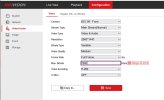If you look at the attached snapshot of the Data Sheet for the DS-E04NI-Q14P Hikvision NVR, you will see that it has an incoming bandwidth of 40Mbps and outgoing bandwidth of 60Mbps.
The problem is that this NVR does not let you set a max bitrate of over 3072, an error message pops up stating that the range must be between 'Range 32-3072'. See attachment.
Currently whether I connect 1 or 2 cameras to the POE ports, it does not let me exceed this setting to get better quality recording. I need to use 8192 to cater for the Frame rate and quality. I could use H264+ or H265+, but do not wish to do so. I normally on all my NVRs use H264.
Is this a bug?
The problem is that this NVR does not let you set a max bitrate of over 3072, an error message pops up stating that the range must be between 'Range 32-3072'. See attachment.
Currently whether I connect 1 or 2 cameras to the POE ports, it does not let me exceed this setting to get better quality recording. I need to use 8192 to cater for the Frame rate and quality. I could use H264+ or H265+, but do not wish to do so. I normally on all my NVRs use H264.
Is this a bug?



